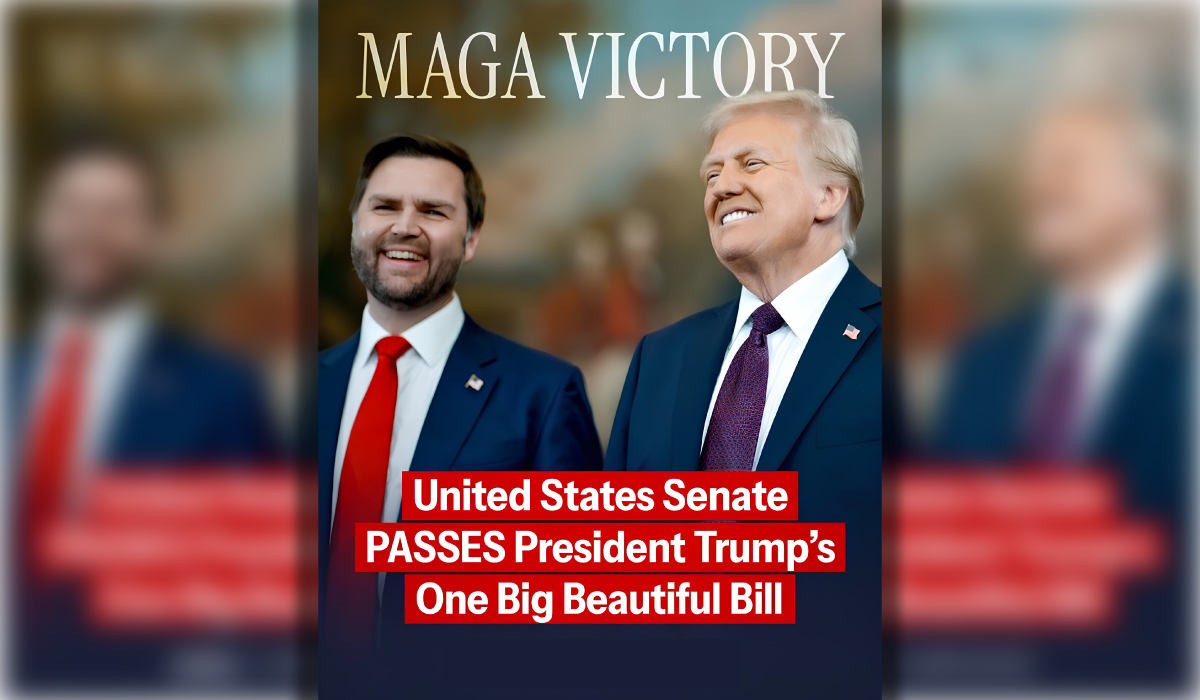President Donald Trump’s very large domestic policy package, also known as the One Big Beautiful Bill Act (OBBB), has overcome a tough Senate vote by a 51-50 count, which is a very big win for the admin’s legislative plan. The huge 940-page package will go back to the House for final passage as Republican leaders, who are very much under the gun to meet Trump’s ambitious July 4th deadline.
Senate Passage: In a Close Decision in the Face of Republican Division
The Senate’s after a 27-hour marathon, which went from Saturday evening until Tuesday morning. Vice President JD Vance broke the tie in favor of the legislation, which up until that point had been against it from 3 Republican senators. Senators Thom Tillis of North Carolina, Susan Collins of Maine, and Rand Paul of Kentucky joined all 47 Democrats in voting against the bill.
In a very close vote, GOP leaders had been in intense behind-the-scenes negotiations. They were frantically trying to gain support from holdout senators, which included Lisa Murkowski from Alaska, who in the end voted for the bill although she had issues with it.
What’s Inside Trump’s Big Beautiful Bill
Massive Tax Cuts and Extensions
The legislation will see the introduction of a $3.8 trillion tax cut over ten years, which is what Trump terms as “the largest middle and working class tax cut in U.S. history”. As for the details of the tax plan, which include:
- Extension of 2017 Trump Tax Cuts: Making the individual tax rates and brackets permanent, which were set to expire in 2025.
- No Tax on Tips and Overtime: Dropping taxes on tips and overtime pay for workers, which cap at $160K.
- Enhanced Child Tax Credit: Increasing the credit by $200 from $2,000 to $2,200, but that which low-income families will not see the full benefit of.
- SALT Deduction Increase: Raising the cap on state and local tax deduction to $40,000 for households which earn under $500,000.
- Section 199A Business Deduction: Broadening the pass-through business deduction from 20% to 23%.
Border Security and Immigration Enforcement
The bill sets forth large sums for Trump’s immigration agenda, which includes:
- Increased Border Security Spending: Billions more for border wall construction and enforcement.
- Mass Deportation Operations: Resources for massive immigration enforcement and deportation programs.
- Immigration Detention Facilities: Funding of new detention centers, which includes the recently opened “Alligator Alcatraz” in Florida.
Medicaid Cuts and Healthcare Changes
One issue which is very contentious is health care program cuts:
- Over the coming 10 years, we will see $930 billion in cuts to Medicaid, which will be brought about by more strict eligibility requirements and work mandates.
- 11.8 out of 10 million Americans will see they are without health insurance as reported by the Congressional Budget Office.
- SNAP cuts that affect food assistance for low-income families.
- $50 billion in support for rural hospitals to weather Medicaid funding cuts.
Student Loan System Overhaul
The great shift in student loan programs, which has seen the introduction of large scale and beautiful (in terms of scope and design) changes to federal education finance in recent years:
New Repayment Structure
- Consolidation to Two Plans: We have gone from 8 current payment options to just 2—a standard plan and a new Repayment Assistance Plan (RAP).
- Extended Forgiveness Timeline: The RAP is requiring 30 years of payment before forgiveness, which is up from the current 20-25 year range.
- Income-Based Payments: Monthly payment options which range from 1% to 10% of adjusted gross income under RAP.
Borrowing Limits
- Graduate Student Caps: Lifetime borrowing for graduate students up to $100,000, $200,000 for medical and law students.
- Parent PLUS Restrictions: Setting at $65,000 for Parent PLUS loans, which also cap annual limits at $20,000.
- End of Grad PLUS Program: Abolishing open access for grad students.
Energy and Environmental Provisions
Biden’s climate change policies are greatly reduced by this.
- Clean Energy Credit Cuts: Reduction of 45Z Clean Fuels Production Credit to $1.00 from $1.75 and its time frame shortened.
- Renewable Energy Rollbacks: Dismantling many green energy incentives under the Inflation Reduction Act.
- Fossil Fuel Support: Increased support of domestic oil and gas production.
Public Opinion and Social Media Reactions
Polling Shows Divided Support
Recent research shows that large scale public doubt is directed at Trump’s bill:
- Fox News Poll: In a 38% support to 59% oppose ratio.
- Quinnipiac Poll: 27% in favor of and 53% against.
- Pew Research: 29% for while 49% against.
- KFF Poll: In a 35% to 64% range favoring the unfavorable side.
Social Media Buzz and Memes
The issue has been a hot topic on social media, which has mainly revolved around the Trump-Musk issue regarding the price of the legislation. Musk, former head of what is now the Department of Government Efficiency, put forth very tough criticism of the $3.3 trillion price tag, which in turn went viral and we saw public back and forth between the two business giants.
Popular social media reactions include:
- Memes of Trump and Musk’s breakup in terms of reality TV.
- Conservative leaning topics on the bill’s provisions.
- Viral content regarding the bill’s effect on rural areas.
House Challenges Ahead
Narrow Republican Majority
Speaker Mike Johnson has a very small margin in the House, where the Republicans have a 220-212 majority. Only the loss of three Republican votes is what the Speaker can afford if all members are present and voting.
Conservative Opposition
Some House Republicans have issues with the Senate version:
- House Freedom Caucus groups that which bill will add to the deficit.
- Rep. Chip Roy and other conservatives put forth that the Senate watered down the House version.
- Rep. Andy Harris, head of the Freedom Caucus, says the bill isn’t ready.
Moderate Republican Concerns
Republicans in high tax states and in districts which have large Medicaid populations worry that:
- No relief on SALT for their constituents.
- Medicaid changes affecting rural hospitals in our districts.
- Political vulnerability in competitive districts.
Economic Impact and Deficit Concerns
Debt Ceiling and Fiscal Impact
The federal debt ceiling has seen an increase of $5 trillion and also we will see $3.3 trillion added to the national debt in the coming ten years. If temporary measures are renewed, the CBO reports we will see even larger costs.
Wealth Distribution Effects
Independent experts report that this bill puts into place what may be the largest scale shift of wealth from the poor to the rich in U.S. history. Also, it is the top 1% of the population (those that earn $663,000 or more) which will see the greatest benefit from the tax cuts.
Timeline and Next Steps
July 4 Deadline Pressure
Trump has put forth a very aggressive Independence Day deadline for final passage, which he has lately modified to a degree. The timeline is that:
- House Rules action set for Wednesday.
- House debate on the floor may be Wednesday or Thursday.
- Final House vote before Independence Day weekend.
Industry and Stakeholder Reactions
Agricultural organizations have different responses. The American Farm Bureau Federation supports the bill, but biofuel groups do against clean energy rollbacks. Also, the Catholic bishops have put forward that this legislation is a failure for “poorest families,” which they attribute to Medicaid and SNAP cuts.
Conclusion: A Turning Point for Trump’s Agenda
Trump’s large scale bill has passed, which is a great achievement for the administration in terms of domestic policy. But in the House, we see very different conservative fiscal hawks are at odds with moderate Republicans over the bill’s scope and cost.
As we head into the final vote, the debate brings to the surface larger issues within the Republican Party, which are that between tax cut priorities and deficit concerns. Also, Democrats are preparing for what they put forth as an attack on health care and social safety net programs.
Whether in July 4 we see the one large beautiful bill become law will depend on Speaker Johnson’s which Republican base support for Trump’s extensive legislative platform and which opposing forces he is able to balance.
News Source: Reuters theguardian theannapurnaexpress




